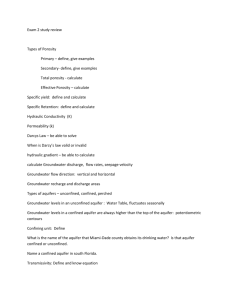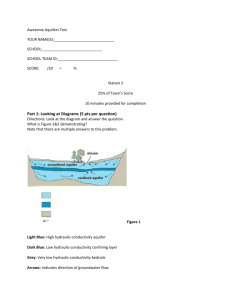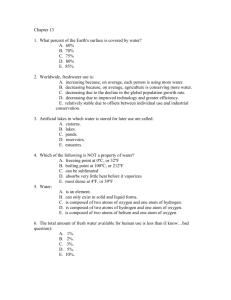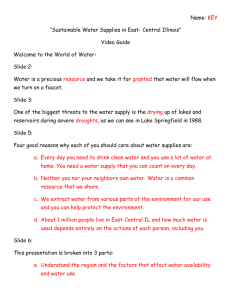the incredible edible aquifer
advertisement
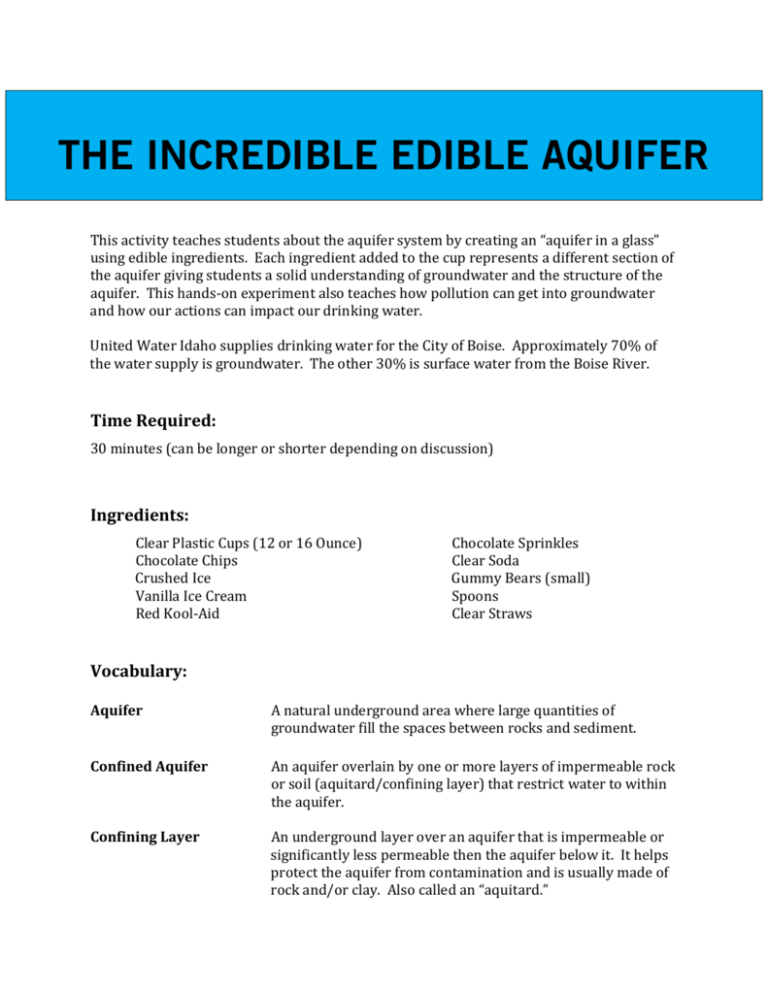
THE INCREDIBLE EDIBLE AQUIFER This activity teaches students about the aquifer system by creating an “aquifer in a glass” using edible ingredients. Each ingredient added to the cup represents a different section of the aquifer giving students a solid understanding of groundwater and the structure of the aquifer. This hands-on experiment also teaches how pollution can get into groundwater and how our actions can impact our drinking water. United Water Idaho supplies drinking water for the City of Boise. Approximately 70% of the water supply is groundwater. The other 30% is surface water from the Boise River. Time Required: 30 minutes (can be longer or shorter depending on discussion) Ingredients: Clear Plastic Cups (12 or 16 Ounce) Chocolate Chips Crushed Ice Vanilla Ice Cream Red Kool-Aid Chocolate Sprinkles Clear Soda Gummy Bears (small) Spoons Clear Straws Vocabulary: Aquifer Confined Aquifer Confining Layer A natural underground area where large quantities of groundwater fill the spaces between rocks and sediment. An aquifer overlain by one or more layers of impermeable rock or soil (aquitard/confining layer) that restrict water to within the aquifer. An underground layer over an aquifer that is impermeable or significantly less permeable then the aquifer below it. It helps protect the aquifer from contamination and is usually made of rock and/or clay. Also called an “aquitard.” Porous Saturated Zones Unconfined Aquifer Unsaturated Zone Water Table Full of pores (small spaces). Water can easily pass through it. An underground layer or area where water fills most of the pores (spaces) in the soil and rock. An aquifer that is not overlain by a layer of impermeable rock or soil. An underground layer or area where air fills most of the pores (spaces) in the soil and rock. The top of an unconfined aquifer. Instructions: Step 1: Fill a clear plastic cup 1/3 full (total) with a combination of gummy bears, chocolate chips, and/or crushed ice. These represent gravels and soils that make up the aquifer. Step 2: Add enough soda to just cover the candy/ice. The soda represents groundwater. Notice that the soda fills all the spaces among the gummy bears, chocolate chips, and ice. The aquifer is now saturated with soda; it is a “saturated zone.” In an unconfined aquifer, the top of the saturated zone is called the “water table.” Step 3: Add a layer of ice cream. This layer, called a “confining layer” or an “aquitard,” is impermeable or significantly less permeable than the aquifer below it (it is difficult for water to soak through). It helps protect the aquifer from contamination and is usually made of rock and/or clay. An aquifer under a confining layer is called a “confined aquifer.” An aquifer without a confining layer is called an “unconfined aquifer.” Step 4: Add crushed ice on top of the confining layer/water table. This represents the unsaturated zone, the area where air fills most of the pores (spaces in the soil and rock. Step 5: Scatter chocolate sprinkles over the top. The sprinkles represent the soil, which is very porous. Step 6: Sprinkle Kool-Aid over the top. The Kool-Aid represents contaminations on the ground (e.g. fertilizer). Does anything happen to the Kool-Aid right away? (Usually nothing will happen.) Step 7: Using a drinking straw, “drill” a “well” into the center of the aquifer. Step 8: Begin to “pump” the well by slowly sucking on the straw. Watch the decline level of the soda and observe what happens to the contaminants. Step 9: Pour a small amount of soda over the top. The soda represents precipitation. It recharges the aquifer (adds new water). Watch contaminants. Review what you have learned and eat your aquifer.






